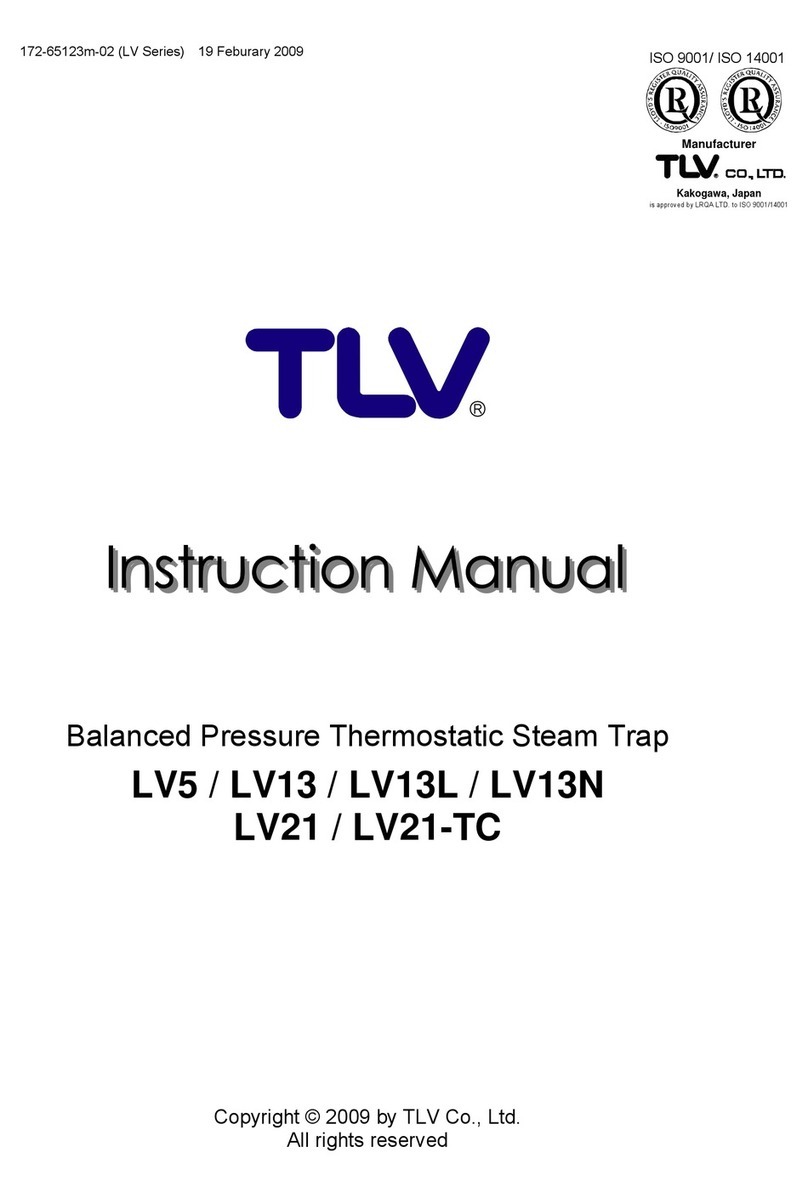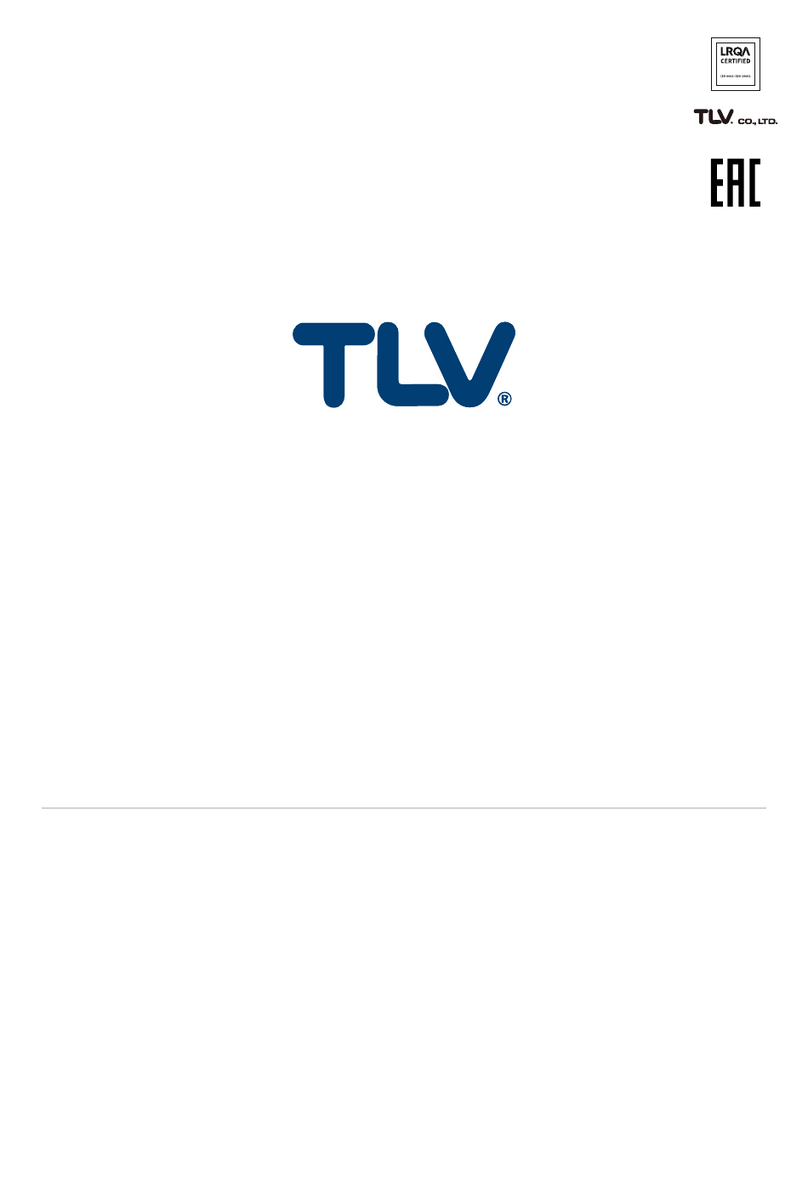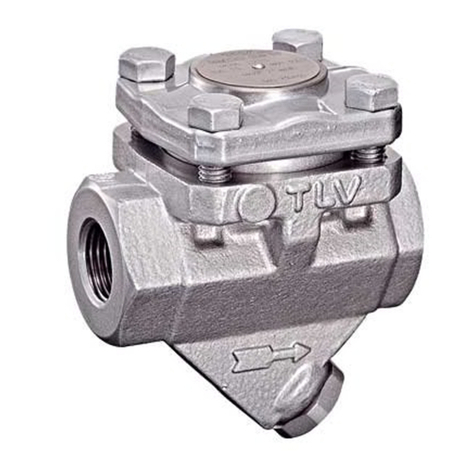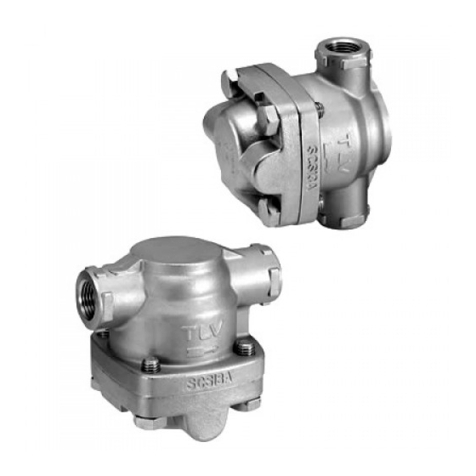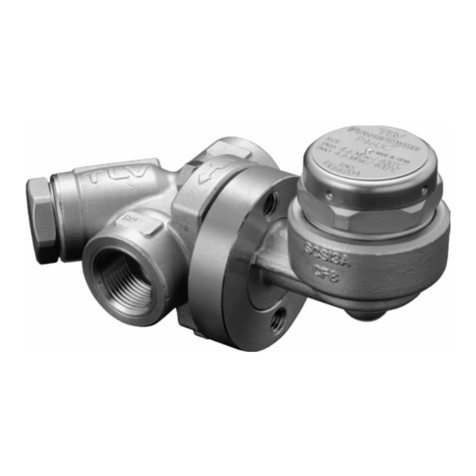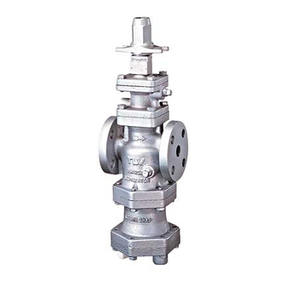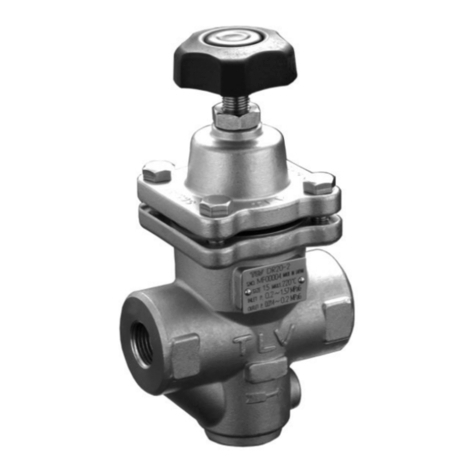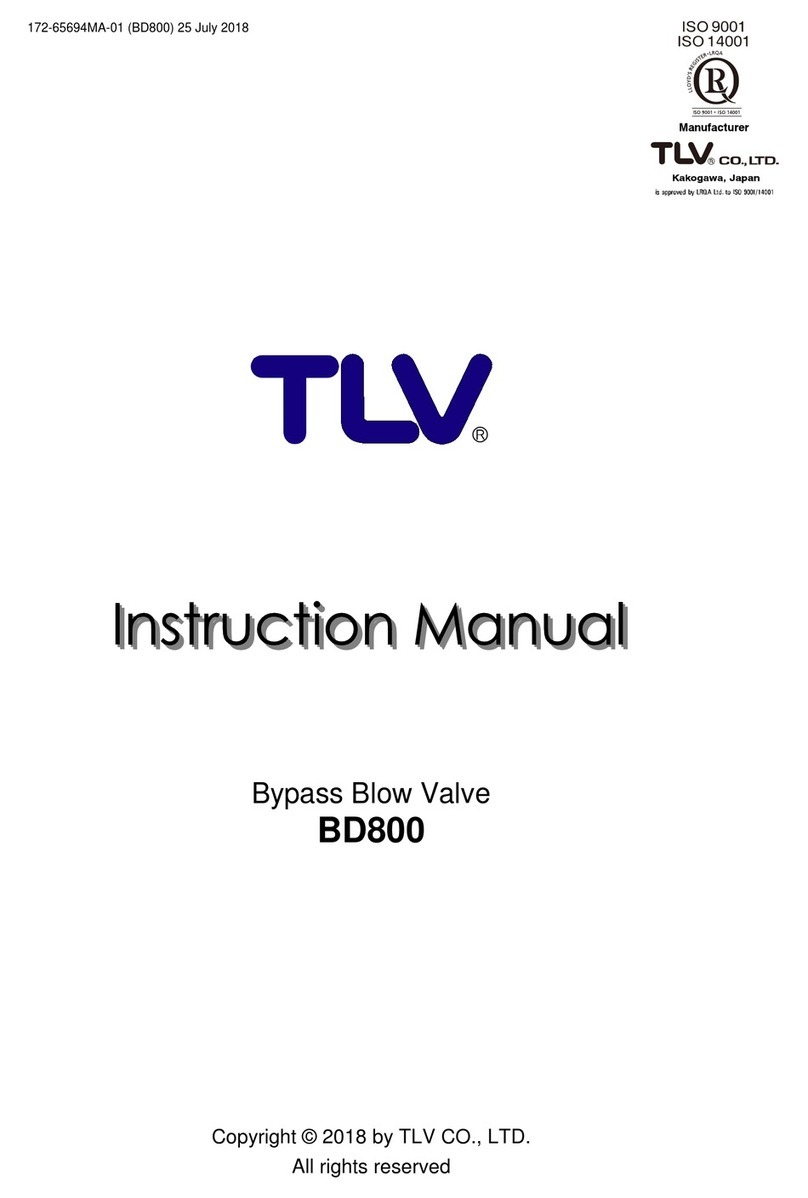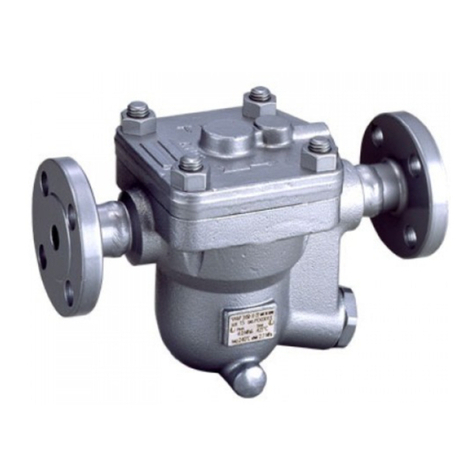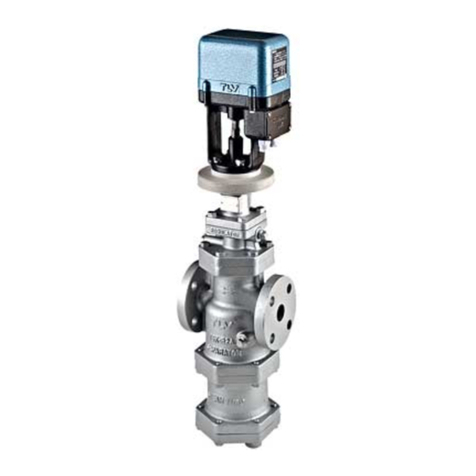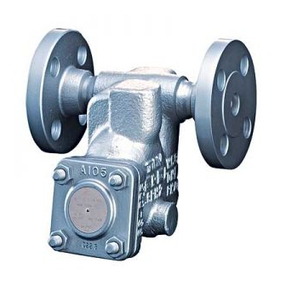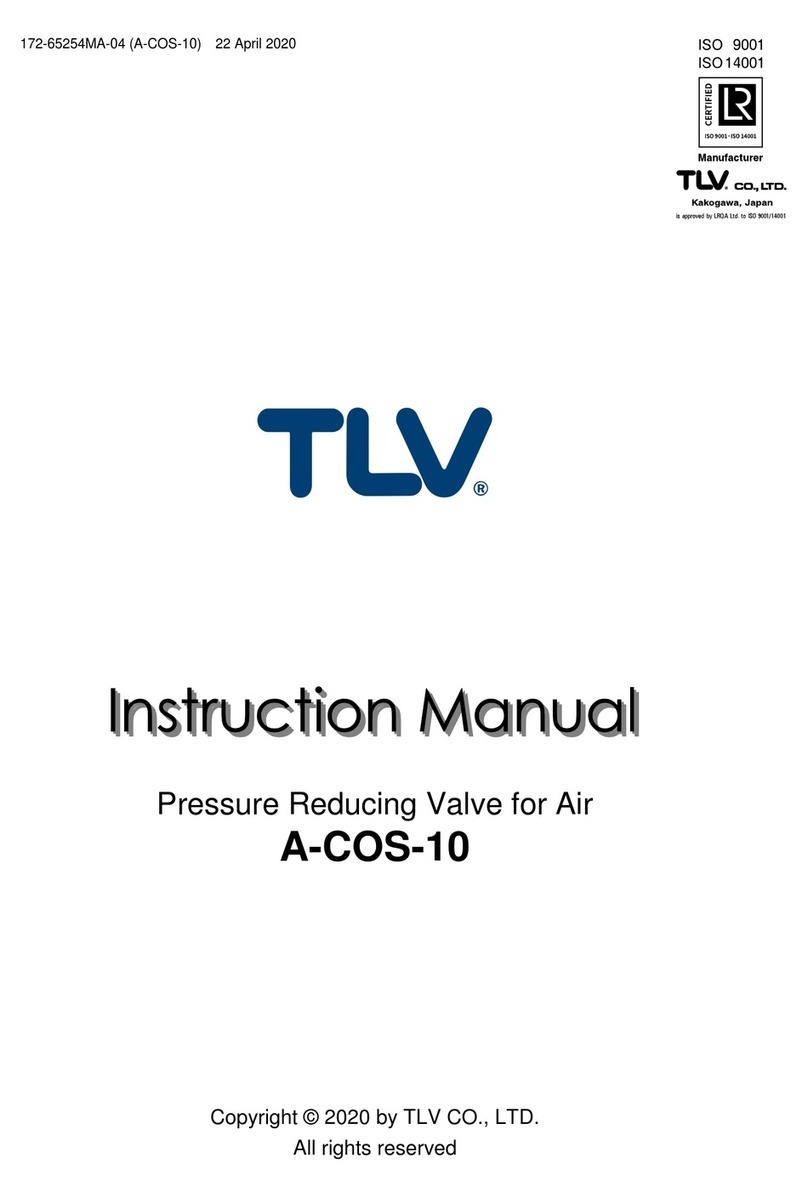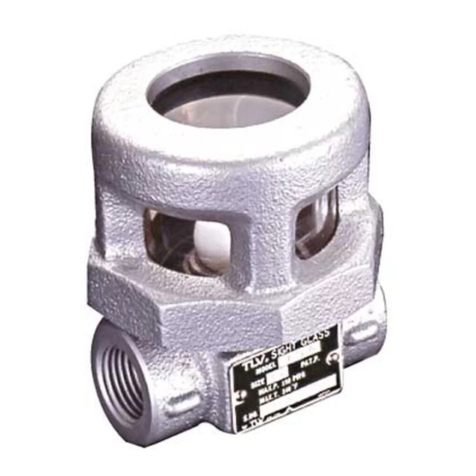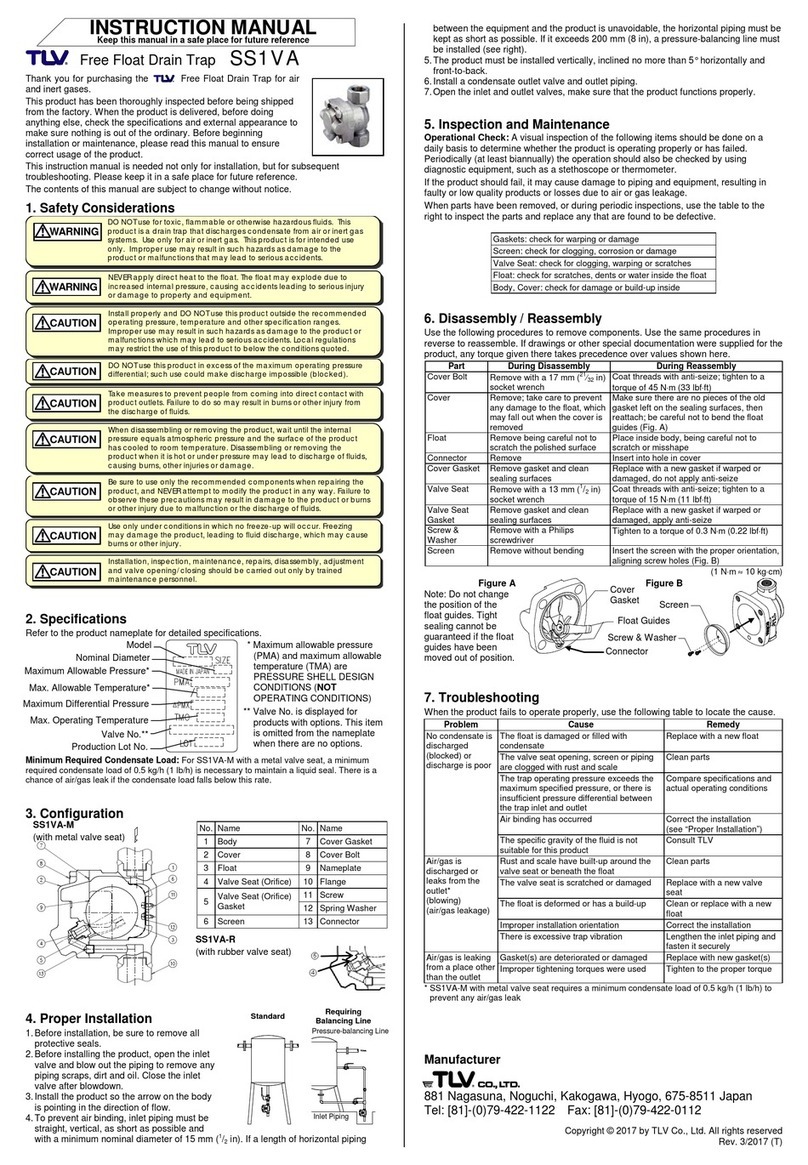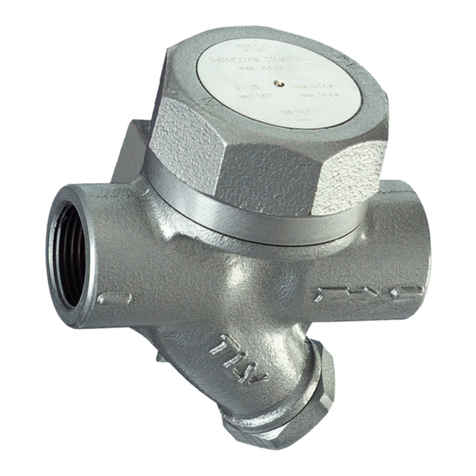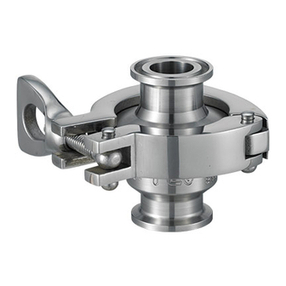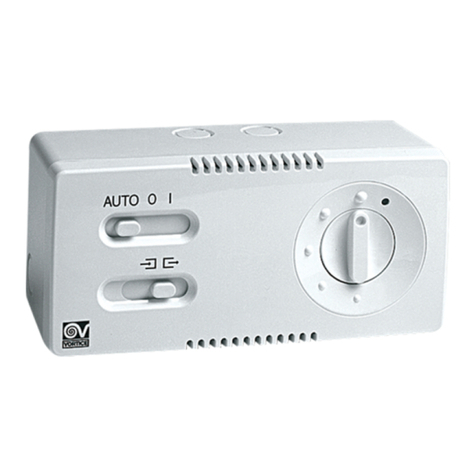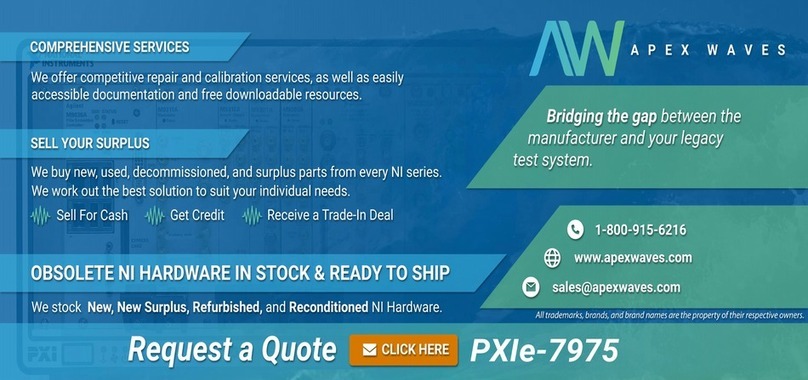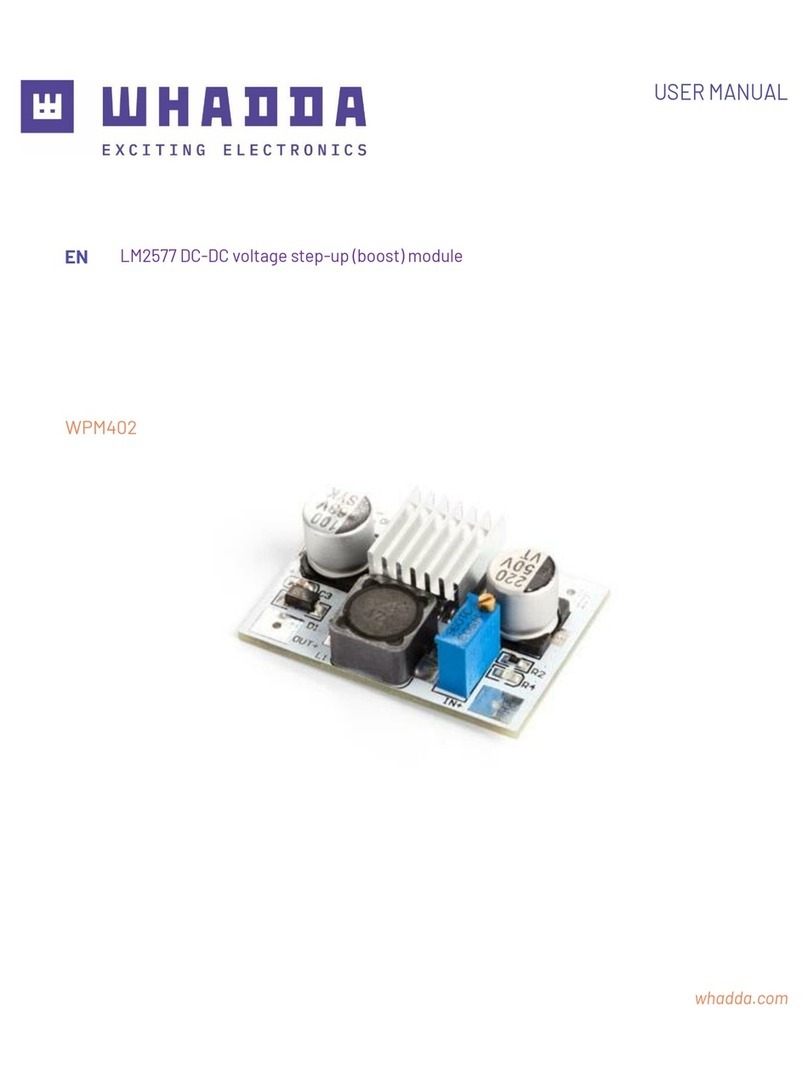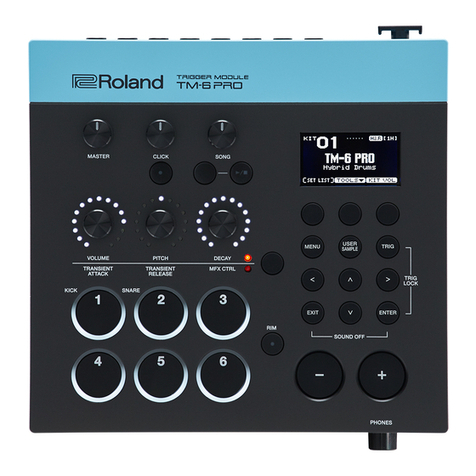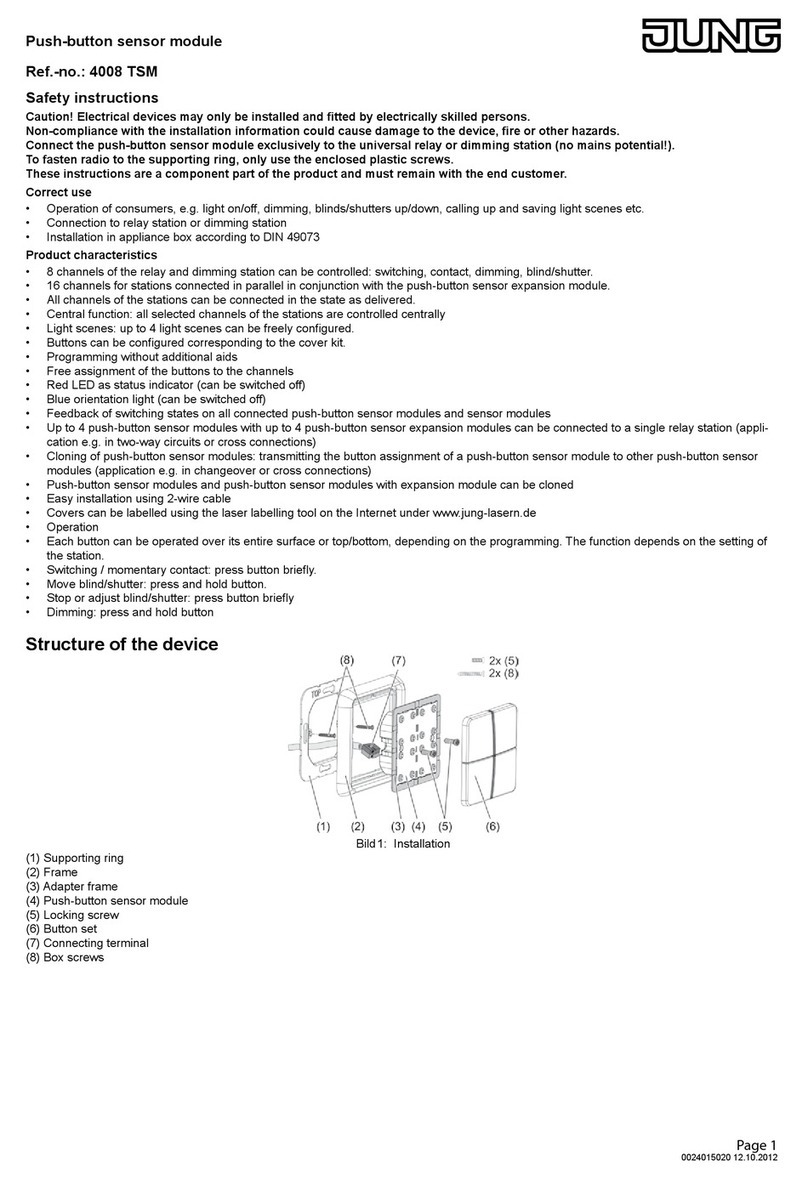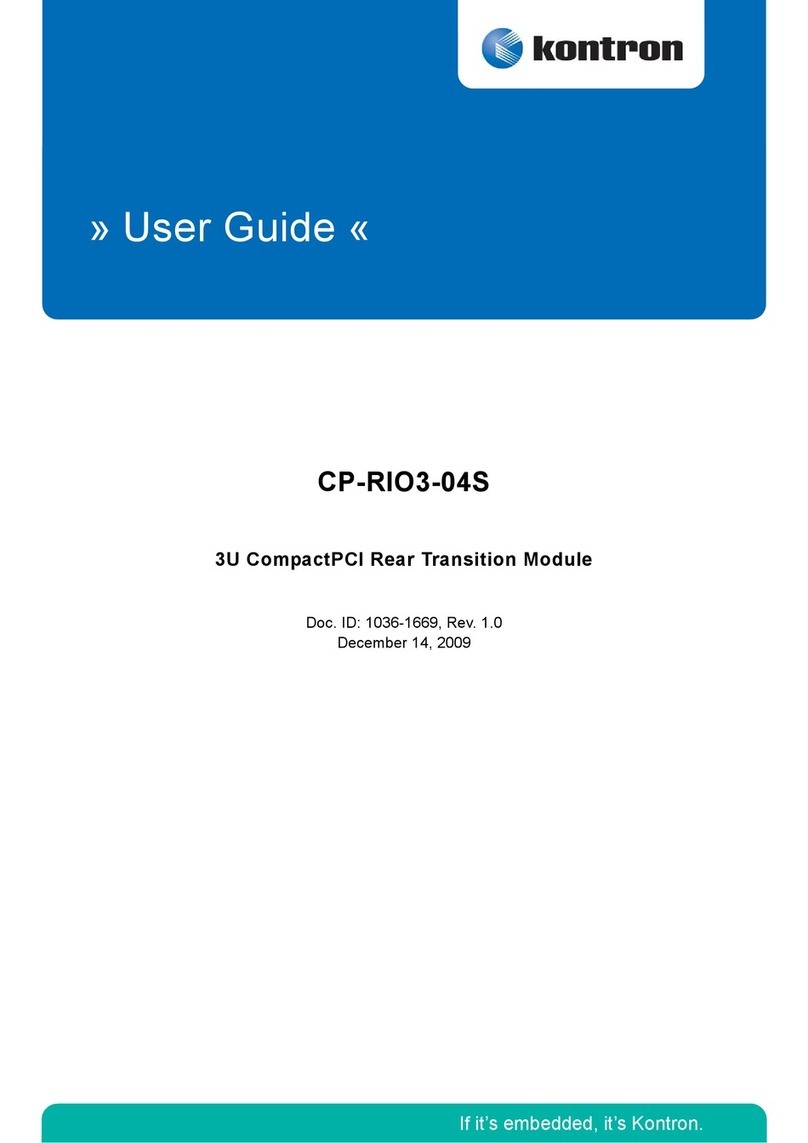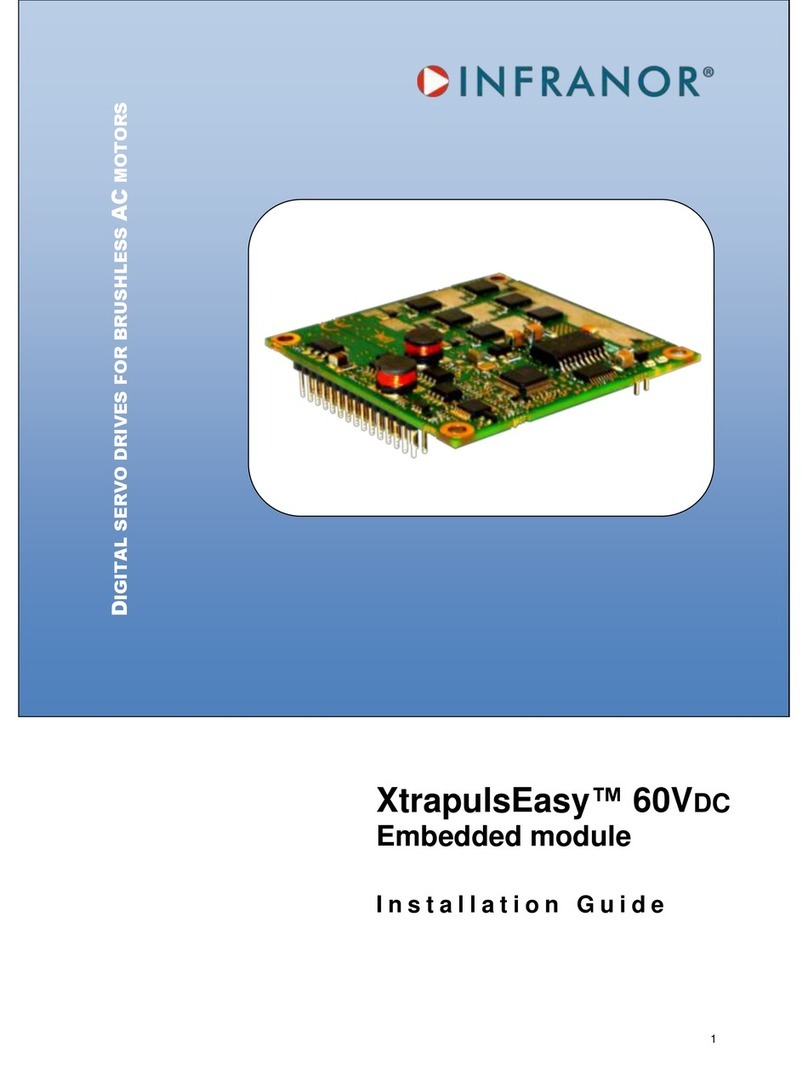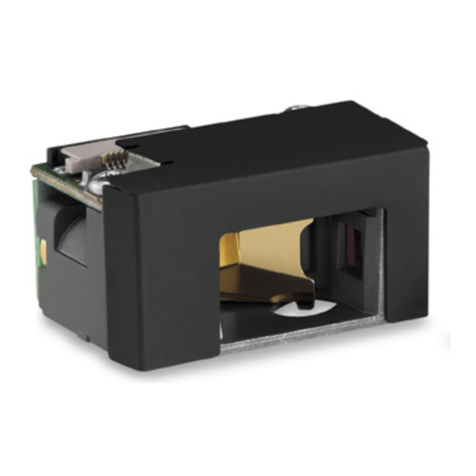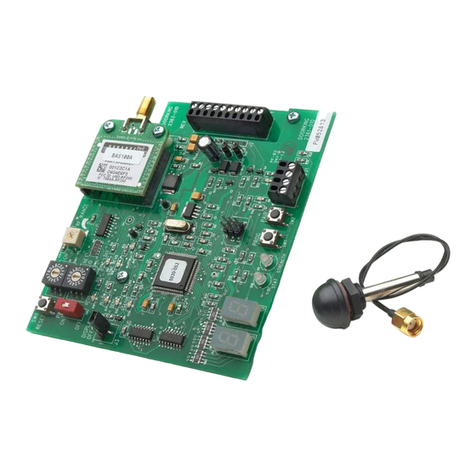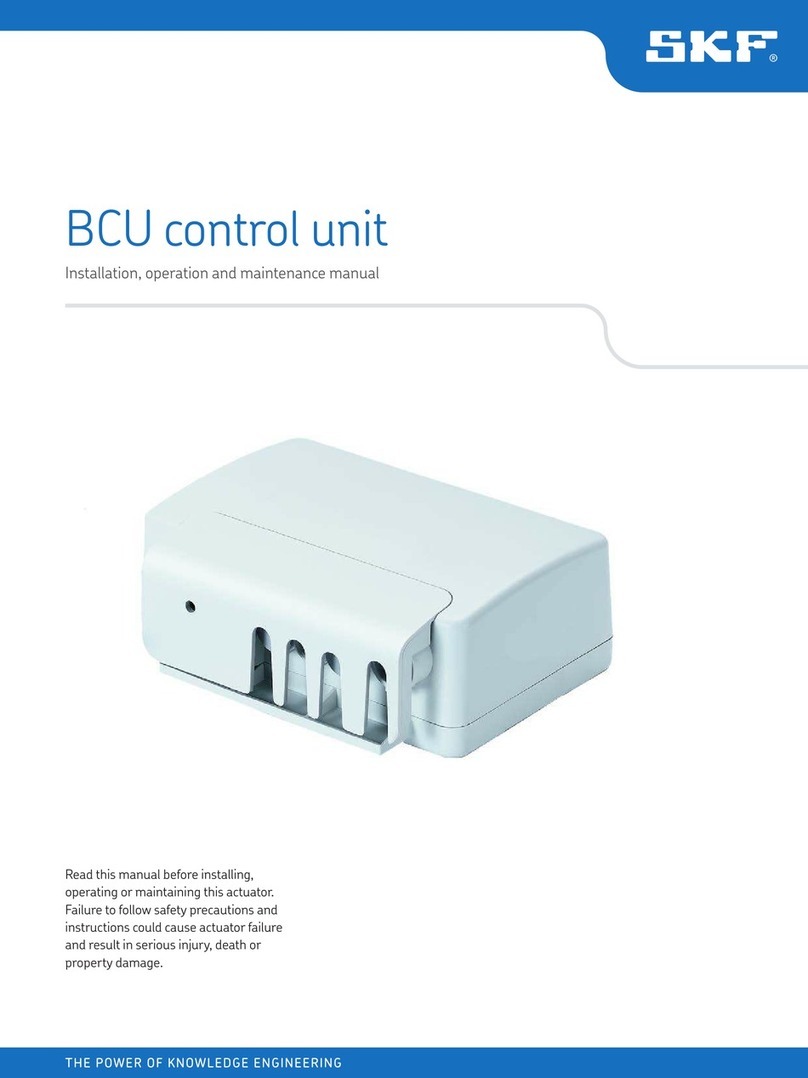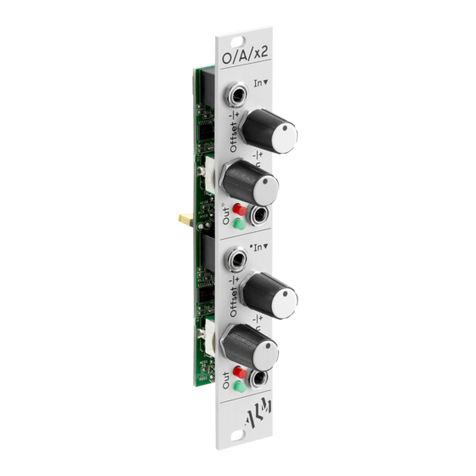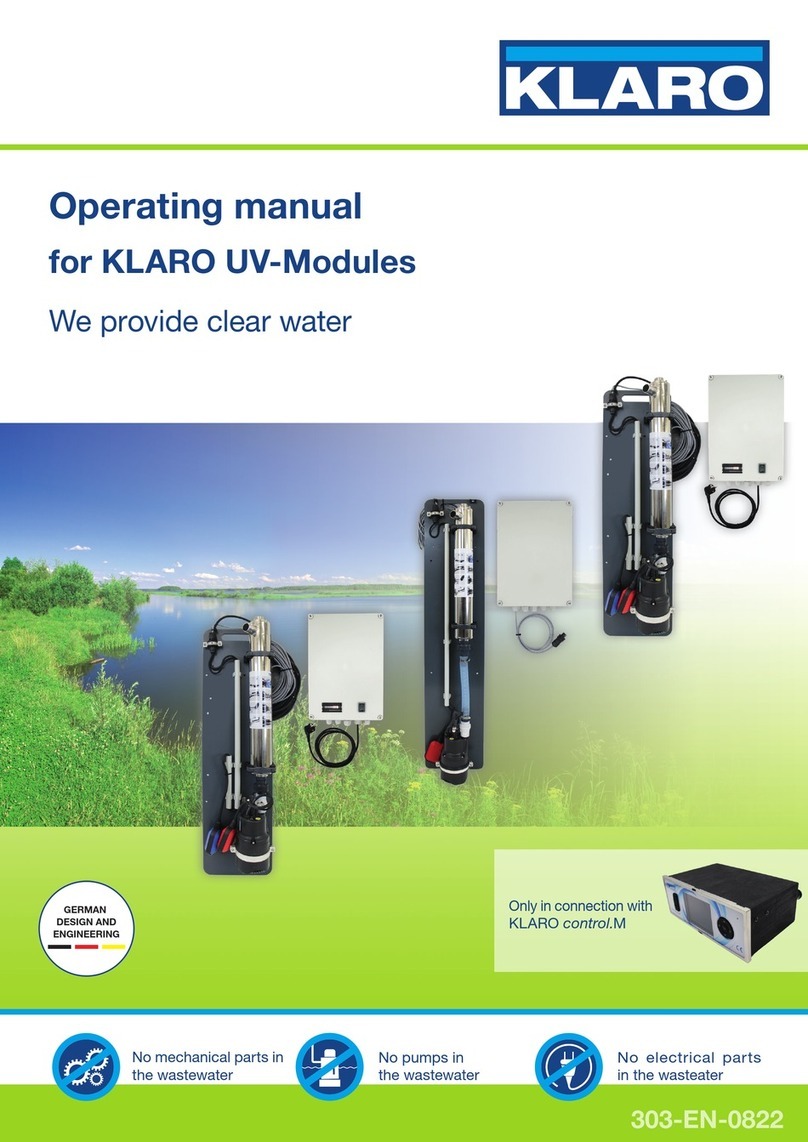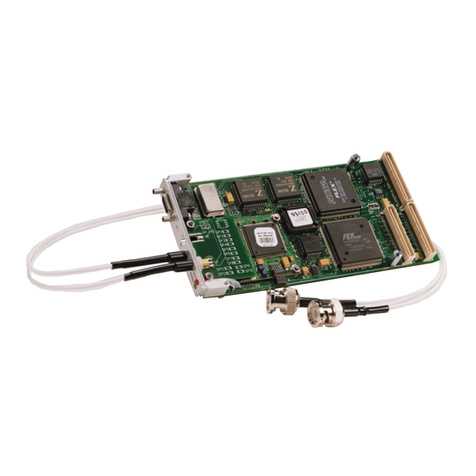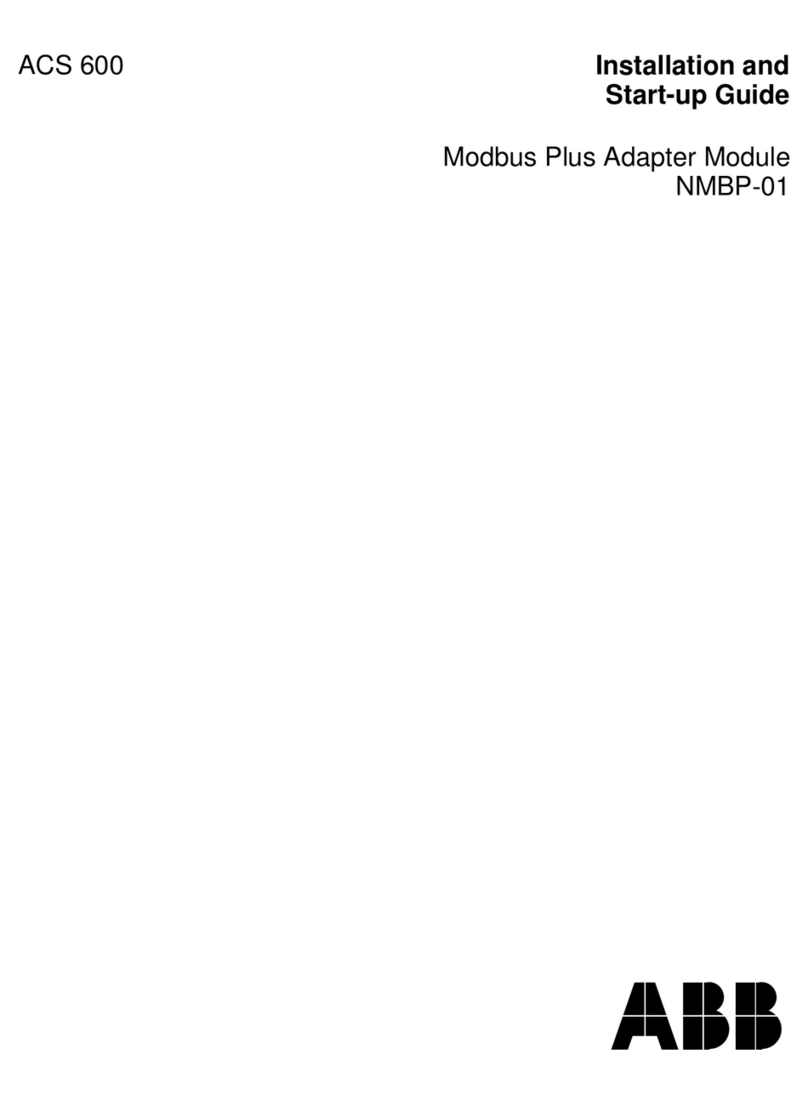TLV JH3S-B User manual

Copyright (C) 2021 by TLV CO., LTD. All rights reserved.
881 Nagasuna, Noguchi, Kakogawa, Hyogo 675-8511, Japan
Manufacturer
Tel: [81]-(0)79-422-1122 Fax: [81]-(0)79-422-0112
JH3S-B/JH5SL-B/JH5SH-B
JH3S-B JH5SL-B
JH5SH-B
INSTRUCTION MANUAL
Keep this manual in a safe place for future reference
FREE FLOAT STEAM TRAPS

Introduction
Before beginning installation or maintenance, please read this manual to ensure correct use of
the product. Keep the manual in a safe place for future reference.
The inline repairable JHS-B series steam traps with thermostatic bimetal air vent are suitable for a
wide range of applications with small-to-large capacities and pressures up
to 6.5 MPaG (925 psig), such as all kinds of heat exchangers, process heaters and coils.
The traps discharge condensate continuously and automatically, at a temperature slightly lower
than saturation temperature.
1 MPa = 10.197 kg/cm2, 1 bar = 0.1 MPa
For products with special specifications or with options not included in this manual, contact TLV
for instructions.
The contents of this manual are subject to change without notice.
Continued on the next page
1. Safety Considerations
• Read this section carefully before use and be sure to follow the instructions.
• Installation, inspection, maintenance, repairs, disassembly, adjustment and valve
opening/closing should be carried out only by trained maintenance personnel.
• The precautions listed in this manual are designed to ensure safety and prevent equipment
damage and personal injury. For situations that may occur as a result of erroneous handling,
three different types of cautionary items are used to indicate the degree of urgency and the
scale of potential damage and danger: DANGER, WARNING and CAUTION.
• The three types of cautionary items above are very important for safety; be sure to observe
all of them, as they relate to installation, use, maintenance, and repair. Furthermore, TLV
accepts no responsibility for any accidents or damage occurring as a result of failure to
observe these precautions.
Indicates an urgent situation
which poses a threat of
death or serious injury.
Indicates that there is a
potential threat of death
or serious injury.
WARNING
CAUTION
WARNING
DANGER CAUTION
Indicates that there is a
possibility of injury or equip-
ment/product damage.
NEVER apply direct heat to the float. The float may explode due to
increased internal pressure, causing accidents leading to serious injury
or damage to property and equipment.
Install properly and DO NOT use this product outside the recommended
operating pressure, temperature and other specification ranges.
Improper use may result in such hazards as damage to the product or
malfunctions, which may lead to serious accidents. Local regulations may
restrict the use of this product to below the conditions quoted.
Take measures to prevent people from coming into direct contact
with product outlets. Failure to do so may result in burns or other injury
from the discharge of fluids.
DO NOT use this product in excess of the maximum operating
pressure differential. Such use could make discharge impossible.
When disassembling or removing the product, wait until the internal
pressure equals atmospheric pressure and the surface of the
product has cooled to room temperature. Disassembling or removing
the product when it is hot or under pressure may lead to discharge of
fluids, causing burns, other injuries or damage.
1

CAUTION
Be sure to use only the recommended components when repairing
the product, and NEVER attempt to modify the product in any way.
Failure to observe these precautions may result in damage to the product
or burns or other injury due to malfunction or the discharge of fluids.
Use only under conditions in which no freeze-up will occur. Freezing
may damage the product, leading to fluid discharge, which may cause
burns or other injury.
Use under conditions in which no water hammer will occur. The
impact of water hammer may damage the product, leading to fluid
discharge, which may cause burns or other injury.
2. Specifications
Refer to the product nameplate for detailed specifications.
* Maximum allowable pressure (PMA) and maximum allowable temperature (TMA) are
PRESSURE SHELL DESIGN CONDITIONS, NOT OPERATING CONDITIONS.
** "Valve No." is displayed for products with options. This item is omitted from the
nameplate when there are no options.
Nominal Diameter
Model
Production Lot No.
Maximum Allowable
Temperature* TMA
Maximum Differential
Pressure
Valve No.**
Maximum Allowable
Pressure*
Maximum Operating
Temperature
To avoid malfunctions, product damage, accidents or serious injury, install
properly and DO NOT use this product outside the specification range. Local
regulations may restrict the use of this product to below the conditions quoted.
CAUTION

3. Configuration
JH3S-B JH5SL-B JH5SH-B
No
1
2
3
4
5
6
7
8
9
MR F
Description
Body
Cover
Float
Orifice
Orifice Gasket
Orifice Plug
Orifice Plug Gasket
Cover Gasket
Float Cover
No
10
11
12
13
14
15
16
17
MR F
Description
Screen
Snap Ring
Air Vent Screen
Snap Ring
Air Vent Valve Plug
Air Vent Valve Seat
Bimetal Plate
Air Vent Case
No
18
19
20
21
22
23
24
25
MR F
Description
Cover Bolt
Cover Nut
Connector
Connector Gasket
Flange or Socket
Nameplate
Drain Plug Gasket*
Drain Plug*
* Option
Replacement kits available: (M) maintenance parts, (R) repair parts, (F) float
Screwed Socket Weld
w
e
!7!0 !9!5 !4!2
yt
i
urq ytur
@1
@3
@4@5
@2o!1 !3
!0
!9
o
!6
w@0
!7 !5 !4!2 i
!1 !3!8
e
q
@2
@2@2
!6
@3 @4 @5
!8

4. Exploded View
!7
Cover Bolt
Cover
w
e
!5
!4
y
t
i
u
r
q
o
!1
!3
Connector
Cover Gasket
Air Vent Valve Seat
Air Vent Case
Air Vent Valve Plug
Bimetal Plate
Snap Ring
Air Vent Screen
Snap Ring
Orifice Plug
Orifice Plug Gasket
Orifice
Orifice Gasket
Body
Float
Float Cover/Screen
Cover
Cover Gasket
Connector
Cover Bolt
Connector gasket
w
i
!8
JH5SL-B
JH5SH-B
JH3S-B
!8
@0
!6
!9
@0
@1
!2
!0
Cover Nut

6. Piping Arrangement
Requirement
Install a catchpot with the
proper diameter.
Diameter is too
small.
Diameter is too
small and inlet
protrudes into pipe.
Rust and scale
flow into the trap
with the
condensate.
Condensate
collects in the
pipe.
Make sure the flow of
condensate is not
obstructed.
To prevent rust and scale
from flowing into the trap,
connect the inlet pipe
25 - 50 mm (1 - 2 in) above
the base of the T - pipe.
When installing on the
blind end, make sure
nothing obstructs the flow
of condensate.
Correct Incorrect
Allowable
Horizontal lnclination
Allowable
Vertical lnclination
1.
Before installation, be sure to remove all protective seals.
2.
Before installing the trap, blow out the inlet piping to remove all dirt and oil.
3. When hoisting the product, hang the rope around the inlet/outlet as close to the body as
possible.
4. Install the steam trap within the allowable inclination, as shown below. Also make sure that
the arrow mark on the body corresponds with the direction of flow.
5.
Install the trap in the lowest part of the pipeline or equipment so the condensate flows naturally
into the trap by gravity. The inlet pipe should be as short and have as few bends as possible.
6.
Support the pipes properly within 800 mm (2.5 ft) on either side of the trap.
7.
Install a bypass valve to discharge condensate, and inlet and outlet valves to isolate the trap in
the event of trap failure or when performing maintenance.
8.
Install a check valve at the trap outlet whenever more than one trap is connected to the
condensate collection pipeline.
9.
The use of unions is recommended to facilitate connection and disconnection of screwed
models.
5. Proper Installation
• Installation, inspection, maintenance, repairs, disassembly, adjustment
and valve opening/closing should be carried out only by trained
maintenance personnel.
• Take measures to prevent people from coming into direct contact with
product outlets.
• Install for use under conditions in which no freeze-up will occur.
• Install for use under conditions in which no water hammer will occur.
CAUTION
5˚5˚
5˚5˚
Continued on the next page
5

1. Is the pipe diameter suitable?
2. Has the trap been installed within the allowable inclination and with the arrow on the body
pointing in the direction of flow?
3. Has sufficient space been secured for maintenance?
4. Have maintenance valves been installed at the inlet and outlet? If the outlet is subject to
back pressure, has a check valve been installed?
5. Is the inlet pipe as short as possible, with as few bends as possible, and installed so that the
condensate will flow naturally down into the trap?
6. Has the piping work been done with the proper methods, as shown in the table on page 5?
Check to make sure that the pipes connected to the trap have been installed properly.
Operational inspections should be performed at least twice per year, or as called for by trap
operating conditions. Steam trap failure may result in temperature drop in the equipment, poor
product quality or losses due to steam leakage.
7. Inspection and Maintenance
WARNING
NEVER apply direct heat to the float. The float may explode due to
increased internal pressure, causing accidents leading to serious injury or
property and equipment damage.
• Installation, inspection, maintenance, repairs, disassembly, adjustment
and valve opening/closing should be carried out only by trained
maintenance personnel.
• Before attempting to open the trap, close the inlet and outlet isolation
valves and wait until the trap has cooled completely. Failure to do so
may result in burns.
• Be sure to use the proper components and NEVER attempt to modify
the product.
CAUTION
Body, Cover(s)
Gaskets
Bimetal Plate
Air Vent Valve (and Seat)
Screen(s)
Float
Orifice Opening
Check inside for damage, dirt, grease, oil film, rust or scale
Check for warping or damage
Check for damage
Check for damage
Check for clogging, corrosion or damage
Check for deformation, damage, oil film or water inside
Check for rust, scale, oil film, wear or damage
Parts Inspection Procedure
Part & No. JH3S-B JH5SH-BJH5SL-B
Tightening Torque and Distance across Flats
Orifice 4
Orifice Plug 6
Air Vent Valve Seat 15
Cover Bolt 18, Nut 19
Drain Plug* 25
* Option
1 N·m
~
~
10 kg·cm
If drawings or other special documentation were supplied for the product, any torque given there
takes precedence over values shown here.
mm
10
24
17
17
21
30
80
30
50
35
N.m
(22)
(59)
(22)
(37)
(26)
(lbf.ft)
(100)
(130)
(22)
(lbf.ft)
(26)
(81)
(100)
(130)
(22)
(lbf.ft)
(26)
(125)
mm
17
19
21
38
21
mm
17
19
21
38
24
(in)
()
4
3
/
(1)
2
1
/
()
16
13
/
()
16
13
/
()
32
21
/
(in)
()
4
3
/
(1)
2
1
/
()
16
13
/
()
16
15
/
()
32
21
/
140
180
30
N.m
35
110
140
180
30
N.m
35
170
(in)
()
32
21
/
()
32
21
/
()
16
15
/
()
16
13
/
()
8
3
/

Disassembly/Reassembly (to reassemble, follow procedures in reverse)
Part & No. JH3S-B JH5SL-B
JH5SH-B During Disassembly
During Reassembly
* *
* *
* Option
Figure A Figure B
Drain Plug 25
Drain Plug Gasket 24
Cover Bolt 18
Cover Nut 19
Cover 2
Cover Gasket 8
Connector 20
Connector
Gasket 21
Snap Ring 11
Air Vent Screen 12
Bimetal Unit
13, 14, 16
Air Vent Valve Seat 15
Air Vent Case 17
Float Cover 9 &
Screen 10
Float 3
Orifice Plug 6
Orifice Plug Gasket 7
Orifice 4
Orifice Gasket 5
Use a wrench to remove
Remove gasket and clean
sealing surfaces
Use a wrench to remove
Remove
Remove gasket and clean
sealing surfaces
Remove the connector
Remove gasket and clean
sealing surfaces
Use appropriate pliers
Remove being careful not
to misshape
Remove bimetal unit
from cover
Use a wrench to remove
Remove from cover
Lift straight up
Remove, careful not to
scratch grounded surface
Use a wrench to remove
Remove gasket and clean
sealing surfaces
Use a wrench to remove
Remove gasket and clean
sealing surfaces
Coat threads with anti-seize and
tighten to the proper torque
Replace with a new gasket, coat
surfaces with anti-seize
Coat threads with anti-seize and
tighten to the proper torque
Align cover with the connector or the
arrow on the body and attach
Replace with a new gasket,
do not apply anti-seize
Insert the connector
Replace with a new gasket,
do not apply anti-seize
Insert securely into groove
Replace being careful not to
misshape
Reinsert in the proper orientation
(see figure A)
Tighten to the proper torque
Place in cover
Align arrows and insert, insert tab on
bottom into guide on body and push
in until top is flush (see figure B)
Insert into body, being careful not to
scratch its grounded surface
Coat threads with anti-seize and
tighten to the proper torque
Replace with a new gasket, coat
surfaces with anti-seize
Coat threads with anti-seize and
tighten to the proper torque
Replace with a new gasket, coat
surfaces with anti-seize
JH3S-B
Arrow
Tab
Snap Ring 11
Air Vent Screen 12
Bimetal Unit 13, 14, 16
Air Vent Valve Seat 15
Air Vent Case 17
JH5SL-B/JH5SH-B

8.
Instructions for Plug / Holder Disassembly and Reassembly
The seal on the threaded plugs/holders found on TLV products is formed by a flat metal
gasket. There are various installation orientations for the gaskets, such as horizontal,
diagonal and downward, and the gasket may be pinched in the thread recesses during
assembly.
Instructions for Disassembly and Reassembly
1Remove the plug/holder using a tool of the specified
size (distance across flats).
2The gasket should not be reused. Be sure to
replace it with a new gasket.
3Clean the gasket surfaces of the plug/holder and the
product body using a rag and/or cleaning agents, then
check to make sure the surfaces are not scratched or
deformed.
4Coat both the gasket surface of the plug/holder and
the threads of the plug/holder with anti-seize, then
press the gasket onto the center of the gasket
surface of the plug/holder, making sure the
anti-seize affixes the gasket tightly to the
plug/holder. Check to make sure the gasket is not
caught in the recesses of the threads.
5Hold the plug/holder upside down to make sure that
the anti-seize makes the gasket stick to the
plug/holder even when the plug/holder is held
upside down.
6Screw the plug/holder by hand into the product body
while making sure that the gasket remains tightly
affixed to the center of the gasket surface of the
plug/holder. Make sure the entire gasket is making
contact with the gasket surface of the product body.
It is important at this point to make sure the gasket
is not pinched in the thread recesses of the
plug/holder.
7Tighten the plug/holder to the proper torque.
8 Next, begin the supply of steam and check to make sure there is no leakage from the part
just tightened. If there is leakage, immediately close the inlet valve and, if there is a bypass
valve, take the necessary steps to release any residual pressure. After the surface of the
product cools to room temperature, repeat the procedure beginning from step 1.
3
5
6
Gasket
Do not pinch gasket
in thread recesses
4Coat with anti-seize
Gasket Surface

9. Operational Check
Normal: Condensate is discharged continuously with flash steam and the sound of flow
can be heard. If there is very little condensate, there is almost no sound of flow.
Blocked: No condensate is discharged. The trap is quiet and makes no noise,
and the surface temperature of the trap is low.
Blowing:
Live steam continually flows from the outlet and there is a continuous metallic sound.
Live steam is discharged through the trap outlet together with the
condensate and there is a high-pitched sound.
A visual inspection can be carried out to aid in determining the necessity for immediate maintenance or repair,
if the trap is open to atmosphere. If the trap does not discharge to atmosphere, use diagnostic equipment
such as TLV TrapMan or TLV Pocket TrapMan (within their pressure and temperature measurement range).
Flash Steam
White jetcontaining
water droplets
Live Steam Leakage
Clear, slightly
bluish jet
(When conducting a visual inspection, flash steam is sometimes mistaken for steam leakage. For
this reason, the use of a steam trap diagnostic instrument such as TLV TrapMan is highly
recommended.)
Steam
Leakage:
10. Troubleshooting
If the expected performance is unachievable after installation of the steam trap, read chapters 5
and 6 again and check the following points for appropriate corrective measures.
NOTE: When replacing parts with new, use the parts list on page 3 for reference, and replace with
parts from the respective replacement parts kits.
Problem
No condensate
is discharged
(blocked) or
discharge is
poor
Steam is
discharged or
leaks from the
trap outlet
(blowing)
(steam leakage)
Steam leaks from
a place other than
the trap outlet
Float is damaged or filled with condensate
The trap operating pressure exceeds the maximum
specified pressure, or there is insufficient pressure
differential between the trap inlet and outlet
Compare specifications
and actual operating
conditions
Steam locking has occurred Blowdown through the
bypass or close the trap
inlet valve and allow the
trap to cool
Rust and scale have accumulated around the
orifice or under the float
Clean
Deterioration of or damage to gaskets
Leakage from eroded cavities of body or cover
Improper tightening torque for cover was used
Replace the gaskets
Replace the trap
Float is
frequently
damaged
Water hammer occurs Examine the piping for
problems that can cause
water hammer
Orifice is damaged Replace with new orifice
Float is deformed or coated with scale Clean or replace the float
The bimetal is damaged Replace with new bimetal
Trap is installed above the maximum allowable
inclination angle
Correct the installation
Vibration of trap occurs Lengthen inlet piping,
then fasten it securely
The bimetal air vent valve surface and/or the air
vent valve seat has a build-up or is scratched
Clean or replace with
new bimetal and/or air
vent valve seat
Replace the float
Cause Remedy
Orifice, screen or piping are clogged with rust or scale
Tighten to the proper torque
The bimetal is damaged Replace with new bimetal
Clean

11. TLV EXPRESS LIMITED WARRANTY
Subject to the limitations set forth below, TLV Corporation, a North Carolina corporation (“TLV”)
warrants that products which are sold by it, TLV CO., LTD., a Japanese corporation (“TLVJ”) or
TLV International, Inc., a Japanese corporation (“TII”), (hereinafter the “Products”) are designed
and manufactured by TLVJ, conform to the specifications published by TLV for the corresponding
part numbers (the “Specifications”) and are free from defective workmanship and materials. With
regard to products or components manufactured by unrelated third parties (the “Components”),
TLV provides no warranty other than the warranty from the third party manufacturer(s), if any.
Exceptions to Warranty
This warranty does not cover defects or failures caused by:
1. improper shipping, installation, use, handling, etc., by other than TLV or service
representatives authorized by TLV; or
2. dirt, scale or rust, etc.; or
3. improper disassembly and reassembly, or inadequate inspection and maintenance by other
than TLV or service representatives authorized by TLV; or
4. disasters or forces of nature or Acts of God; or
5. abuse, abnormal use, accidents or any other cause beyond the control of TLV; or
6. improper storage, maintenance or repair; or
7. operation of the Products not in accordance with instructions issued with the Products or with
accepted industry practices; or
8. use for a purpose or in a manner for which the Products were not intended; or
9. use of the Products in a manner inconsistent with the Specifications; or
10. use of the Products with Hazardous Fluids (fluids other than steam, air, water, nitrogen,
carbon dioxide and inert gases (helium, neon, argon, krypton, xenon and radon)); or
11. failure to follow the instructions contained in the TLV Instruction Manual for the Product.
Duration of Warranty
This warranty is effective for a period of the earlier of: (i) three (3) years after delivery of Products
to the first end user in the case of sealed SST-Series Products for use in steam pressure service
up to 650 psig; (ii) two (2) years after delivery of Products to the first end user in the case of
PowerTrap® units; or (iii) one (1) year after delivery of Products to the first end user in the case of
all other Products. Notwithstanding the foregoing, asserting a claim under this warranty must be
brought by the earlier of one of the foregoing periods, as applicable, or within five (5) years after
the date of delivery to the initial buyer if not sold initially to the first end user.
ANY IMPLIED WARRANTIES NOT NEGATED HEREBY WHICH MAY ARISE BY OPERATION OF
LAW, INCLUDING THE IMPLIED WARRANTIES OF MERCHANTABILITY AND FITNESS FOR A
PARTICULAR PURPOSE AND ANY EXPRESS WARRANTIES NOT NEGATED HEREBY, ARE
GIVEN SOLELY TO THE INITIAL BUYER AND ARE LIMITED IN DURATION TO ONE (1) YEAR
FROM THE DATE OF SHIPMENT BY TLV.
Exclusive Remedy
THE EXCLUSIVE REMEDY UNDER THIS WARRANTY, UNDER ANY EXPRESS WARRANTY OR
UNDER ANY IMPLIED WARRANTIES NOT NEGATED HEREBY (INCLUDING THE IMPLIED
WARRANTIES OF MERCHANTABILITY AND FITNESS FOR A PARTICULAR PURPOSE), IS
REPLACEMENT;
PROVIDED: (a) THE CLAIMED DEFECT IS REPORTED TO TLV IN WRITING
WITHIN THE APPLICABLE WARRANTY PERIOD, INCLUDING A DETAILED WRITTEN
DESCRIPTION OF THE CLAIMED DEFECT AND HOW AND WHEN THE CLAIMED DEFECTIVE
PRODUCT WAS USED; AND (b) THE CLAIMED DEFECTIVE PRODUCT AND A COPY OF THE
PURCHASE INVOICE IS RETURNED TO TLV, FREIGHT AND TRANSPORTATION COSTS
PREPAID, UNDER A RETURN MATERIAL AUTHORIZATION AND TRACKING NUMBER ISSUED
BY TLV. ALL LABOR COSTS, SHIPPING COSTS, AND TRANSPORTATION COSTS
ASSOCIATED WITH THE RETURN OR REPLACEMENT OF THE CLAIMED DEFECTIVE
PRODUCT ARE SOLELY THE RESPONSIBILITY OF BUYER OR THE FIRST END USER. TLV
RESERVES THE RIGHT TO INSPECT ON THE FIRST END USER’S SITE ANY PRODUCTS
CLAIMED TO BE DEFECTIVE BEFORE ISSUING A RETURN MATERIAL AUTHORIZATION.
SHOULD SUCH INSPECTION REVEAL, IN TLV’S REASONABLE DISCRETION, THAT THE
10

13901 South Lakes Drive, Charlotte, NC 28273-6790, U.S.A.
Tel: [1]-704-597-9070 Fax: [1]-704-583-1610
Printed on recycled paper.
Rev. 10/2021 (M)PAC-65484-a
CLAIMED DEFECT IS NOT COVERED BY THIS WARRANTY, THE PARTY ASSERTING THIS
WARRANTY SHALL PAY TLV FOR THE TIME AND EXPENSES RELATED TO SUCH ON-SITE
INSPECTION.
Exclusion of Consequential and Incidental Damages
IT IS SPECIFICALLY ACKNOWLEDGED THAT THIS WARRANTY, ANY OTHER EXPRESS
WARRANTY NOT NEGATED HEREBY, AND ANY IMPLIED WARRANTY NOT NEGATED
HEREBY, INCLUDING THE IMPLIED WARRANTIES OF MERCHANTABILITY AND FITNESS FOR
A PARTICULAR PURPOSE, DO NOT COVER, AND NEITHER TLV, TII NOR TLVJ WILL IN ANY
EVENT BE LIABLE FOR, INCIDENTAL OR CONSEQUENTIAL DAMAGES, INCLUDING, BUT NOT
LIMITED TO LOST PROFITS, THE COST OF DISASSEMBLY AND SHIPMENT OF THE
DEFECTIVE PRODUCT, INJURY TO OTHER PROPERTY, DAMAGE TO BUYER’S OR THE FIRST
END USER’S PRODUCT, DAMAGE TO BUYER’S OR THE FIRST END USER’S PROCESSES,
LOSS OF USE, OR OTHER COMMERCIAL LOSSES. WHERE, DUE TO OPERATION OF LAW,
CONSEQUENTIAL AND INCIDENTAL DAMAGES UNDER THIS WARRANTY, UNDER ANY
OTHER EXPRESS WARRANTY NOT NEGATED HEREBY OR UNDER ANY IMPLIED WARRANTY
NOT NEGATED HEREBY (INCLUDING THE IMPLIED WARRANTIES OF MERCHANTABILITY AND
FITNESS FOR A PARTICULAR PURPOSE) CANNOT BE EXCLUDED, SUCH DAMAGES ARE
EXPRESSLY LIMITED IN AMOUNT TO THE PURCHASE PRICE OF THE DEFECTIVE PRODUCT.
THIS EXCLUSION OF CONSEQUENTIAL AND INCIDENTAL DAMAGES, AND THE PROVISION
OF THIS WARRANTY LIMITING REMEDIES HEREUNDER TO REPLACEMENT, ARE
INDEPENDENT PROVISIONS, AND ANY DETERMINATION THAT THE LIMITATION OF
REMEDIES FAILS OF ITS ESSENTIAL PURPOSE OR ANY OTHER DETERMINATION THAT
EITHER OF THE ABOVE REMEDIES IS UNENFORCEABLE, SHALL NOT BE CONSTRUED TO
MAKE THE OTHER PROVISIONS UNENFORCEABLE.
Exclusion of Other Warranties
THIS WARRANTY IS IN LIEU OF ALL OTHER WARRANTIES, EXPRESS OR IMPLIED, AND ALL
OTHER WARRANTIES, INCLUDING BUT NOT LIMITED TO THE IMPLIED WARRANTIES OF
MERCHANTABILITY AND FITNESS FOR A PARTICULAR PURPOSE, ARE EXPRESSLY
DISCLAIMED.
Severability
Any provision of this warranty which is invalid, prohibited or unenforceable in any jurisdiction
shall, as to such jurisdiction, be ineffective to the extent of such invalidity, prohibition or
unenforceability without invalidating the remaining provisions hereof, and any such invalidity,
prohibition or unenforceability in any such jurisdiction shall not invalidate or render unenforceable
such provision in any other jurisdiction.
Other manuals for JH3S-B
1
This manual suits for next models
2
Table of contents
Other TLV Control Unit manuals

